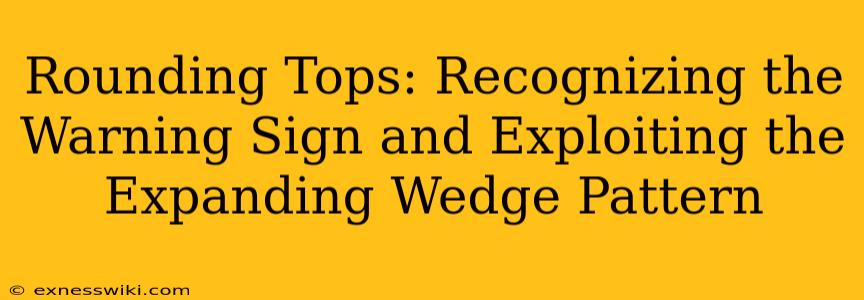Remember that time you were absolutely sure a stock was about to skyrocket? You had all the indicators lined up, the news was buzzing, and your gut feeling screamed "buy!" But then, instead of soaring, the stock started to wobble, then dipped, and finally plummeted. This, my friends, is a classic example of how a seemingly bullish signal can actually be a warning sign. In this case, it could have been a rounding top pattern – a deceptive chart formation that often signals a shift in market sentiment from bullish to bearish.
The Rounding Top: A Stealthy Bearish Signal
In my opinion, the rounding top is one of the trickiest chart patterns to spot. It's often mistaken for a consolidation period before another bullish surge. However, a closer look reveals the subtle signs of a reversal. The rounding top pattern forms when a stock's price rises to a peak, then starts to retrace its gains, forming a rounded, bowl-like shape at the top.
Think of it like a balloon slowly deflating. At first, it might seem like the balloon is just taking a pause before inflating further. But as the deflation continues, it becomes clear that the balloon is losing its air, and the upward trajectory is gone.
Here's where things get interesting: while the rounding top itself indicates a potential shift, it's often combined with another pattern called the expanding wedge. This pattern, when correctly identified, can give you a powerful tool to anticipate and potentially profit from the reversal.
The Expanding Wedge: A Roadmap to the Downside
Imagine a pair of chopsticks pushing the price of a stock higher. The expanding wedge pattern is characterized by a series of higher highs and higher lows. This pattern resembles a widening wedge, with the angle of the wedge continuously increasing as the price moves upward.
However, the widening angle of the expanding wedge doesn't always mean the price will continue to rise. In fact, the opposite is often true. This widening wedge can act as a trap, luring traders into a false sense of security. The widening angle signifies a loss of momentum, and the price tends to break down after the wedge forms.
Identifying the Pattern and Seizing the Opportunity
The combination of the rounding top and expanding wedge forms a powerful bearish signal. Identifying this pattern requires a keen eye for detail and a fundamental understanding of the market. To properly analyze this combo, you should:
- Identify a rounding top: Look for a rounded peak in the price chart, with the price retracing its gains.
- Recognize the expanding wedge: Find a series of higher highs and higher lows within the rounding top, forming a widening wedge.
- Confirm the breakout: Wait for the price to break below the lower boundary of the wedge.
- Place your trade: Once the breakout is confirmed, consider placing a short position, aiming to profit from the downward movement.
It's important to remember that no trading strategy is foolproof. The rounding top and expanding wedge combination is a powerful tool, but it shouldn't be relied upon solely for decision making. Always conduct thorough research, consider the overall market conditions, and manage your risk effectively.
Beyond the Charts: Understanding the Underlying Factors
While the rounding top and expanding wedge are technical patterns, it's crucial to understand the underlying reasons for the price shift. Consider factors such as company fundamentals, industry news, and overall market sentiment. These factors can provide valuable insights into the potential for a reversal and help you make informed trading decisions.
Example: Netflix in 2022
Let's take a look at Netflix, a company that experienced a sharp decline in 2022. The stock formed a rounding top pattern around its all-time highs, indicating potential weakness. This pattern was further confirmed by an expanding wedge, which emerged as the stock's price continued to rise. The breakout below the wedge's lower boundary led to a significant decline in the stock price, validating the bearish signals.
Conclusion
While the rounding top and expanding wedge may appear deceptive, they are powerful indicators of potential market reversals. Understanding and correctly identifying these patterns can help you anticipate price movements and make informed trading decisions. However, remember to approach all trading strategies with caution, conduct thorough research, and manage your risk effectively. After all, the market is constantly changing, and the more you understand its nuances, the better equipped you'll be to navigate its ups and downs.
